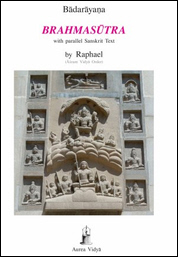
Notes on Shankara’s examination of the nature of ‘Error’ in the introduction to the brahmasUtra.
Objections to the theory
Other systems of philosophy claim that, although the rope-snake error is acceptable, the superimposition of anything onto the Atman is not possible. The argument is that any superimposition requires four conditions to be satisfied:
- Perception. The object being covered must be directly perceivable, as is the rope in the rope-snake example. The Atman is not an object and cannot be perceived.
- Incompletely known. The object must be incompletely known, as one is ignorant of the fact that the rope is a rope. In the case of the Atman , however, the advaitin accepts that the Atman is self-evident and always conscious – how can there be ignorance with regard to something that is self-evident?
- Similarity. There must be some similarity between the actual object and its superimposition, just as a rope and snake have a basic similarity (one could not mistake the rope for an elephant, for example). But there is total dissimilarity between the Atman and anything else. E.g. Atma is the subject, anAtma is the object; Atma is conscious and all pervading, anAtma is inert and limited etc.
- Prior experience. In order to make the mistake, we must have had prior experience of that which is superimposed. We could not see a snake where the rope is unless we knew what a real snake was. Whilst this is possible in the case of the rope-snake, it is not possible in the Atma–anAtma case because we would have to have prior experience of a ‘real’ anAtma and it is part of the fundamental teaching of advaita that there is no such thing; there is only the Atman.
Accordingly, in the case of the Atma–anAtma , not one of these four conditions is satisfied. Therefore superimposition of anAtma onto Atma, the fundamental cause of our error according to Shankara, is not possible – so says the objector. Continue reading


 I came across this essay last week. I don’t actually remember writing it, although the file was dated Feb of this year! (My memory must be deteriorating faster than I thought!) Anyway, since everyone (who contributes these days) seems to be particularly interested in Consciousness and scientific views, it seemed a good idea to post it. Apologies if I have already posted it somewhere before…
I came across this essay last week. I don’t actually remember writing it, although the file was dated Feb of this year! (My memory must be deteriorating faster than I thought!) Anyway, since everyone (who contributes these days) seems to be particularly interested in Consciousness and scientific views, it seemed a good idea to post it. Apologies if I have already posted it somewhere before…

